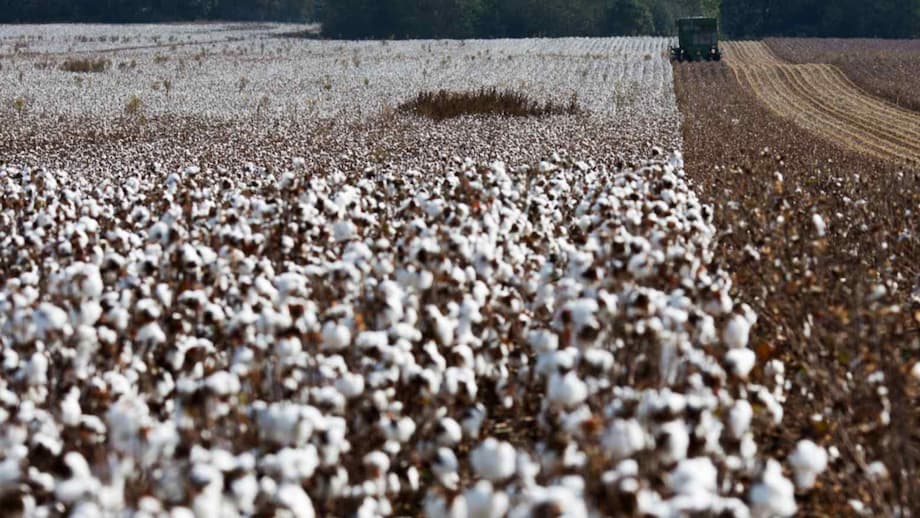A rapid shift in demand for US fiber
US cotton exporters are experiencing one of the sharpest swings in trade flows in years. Shipments to China collapsed in early 2025, while sales to other Asian markets accelerated. Nikkei reporting cited by Agenzia Nova said US cotton exports to China fell about 90 percent in the first six months of 2025, even as deliveries to countries such as Vietnam, Pakistan, and Turkey rose, with Vietnam’s intake nearly tripling. The reversal is tied to a broad reshaping of apparel sourcing and a new round of tariffs that raised the cost of buying garments made in China and, more recently, India.
- A rapid shift in demand for US fiber
- How tariffs reshaped apparel sourcing
- Xinjiang, import bans, and China’s cotton constraints
- Vietnam’s rise as a spinning and sewing hub
- Where US cotton goes if not China
- How a bale becomes a T shirt, the yarn detour
- What brands and retailers are doing now
- What comes next for growers and mills
- Key Points
The United States is the world’s leading cotton exporter by volume, supplying roughly one third of global exports, according to the US Department of Agriculture’s Economic Research Service. In a normal year, China, Bangladesh, and Vietnam are among the largest importers of raw fiber. That structure still holds, but the destination of US cotton is changing as clothing brands divert orders to South and Southeast Asia and as policy constraints limit China’s use of imported fiber. The result is fewer bales headed straight to Chinese ports and more bales moving to Vietnam, Pakistan, Bangladesh, and Turkey, where yarn mills and garment factories are running hard to capture new orders.
USDA’s August 2025 Cotton: World Markets and Trade update highlighted the same pattern, noting that US exports surged to markets outside China as apparel sourcing migrated. The agency pointed to weaker Chinese consumption and continued redirection of US buyer orders toward alternative manufacturing centers. The broad message from data and industry is consistent, a China slowdown on raw cotton imports and a rise in demand in competing hubs that now sew a larger share of the world’s clothes.
What the latest numbers show
Multiple news outlets reported the 90 percent drop in US shipments to China in early 2025, a swing more severe than typical year to year volatility. By contrast, Vietnam’s purchases of US cotton almost tripled in the same period, while Pakistan and Turkey also booked larger volumes. Vietnam has built a giant apparel export engine, shipping an estimated 44 billion dollars of textiles and garments in 2024, according to VietnamPlus, and that scale requires steady inflows of fiber and yarn. The combination of stronger orders and tariff advantages for some finished products has lifted Vietnam’s clout in the US apparel market.
How tariffs reshaped apparel sourcing
The newest round of US reciprocal tariffs raised effective duty rates on apparel imports from several countries in 2025, with the rates and timing reported across regional media. Prothom Alo English and South Asia Monitor describe a policy framework that left Vietnam and Bangladesh facing a 20 percent additional tariff while China carried a higher overall rate. India’s effective tariff for many apparel lines rose to about 50 percent after an extra 25 percent was added. That change rattled Indian exporters and pushed some US buyers to rethink where their goods are made.
Reuters reported that a large Indian garment exporter, Pearl Global, told clients it could shift orders to its factories in Bangladesh, Indonesia, Vietnam, or Guatemala to avoid higher US duties on India. Buyers also asked some Indian suppliers to pause shipments or absorb the cost increases. Those signals, paired with similar decisions among Chinese producers, are sending more cut and sew work to Southeast Asia. Vietnam, already a core sourcing hub for major brands, is a leading beneficiary.
At the macro level, the tariff debate is intertwined with inflation and growth. In March 2025, Federal Reserve Chair Jerome Powell addressed the broad economic effects of tariffs while discussing interest rates and consumer spending. He observed that tariffs tend to weigh on growth while lifting price pressures.
Speaking at that time as reported by Cotton Grower magazine, Powell cautioned against reading too much into short term numbers but was clear on the directional effect of trade taxes.
Tariffs tend to bring growth down, and they tend to bring inflation up.
Brands are not waiting to see the full demand impact. They are spreading risk by booking more production in Vietnam, Bangladesh, and Indonesia. That, in turn, reallocates raw cotton demand away from China and toward the places where spinning and sewing are now concentrated.
Xinjiang, import bans, and China’s cotton constraints
China’s capacity to use imported fiber is shaped by geography and policy. In recent years, nearly 90 percent of China’s cotton has been grown in Xinjiang, thousands of miles from the main textile clusters along the coast. ERS research explains that China limits raw cotton imports through a tariff rate quota system set at 894,000 metric tons at a 1 percent tariff, with occasional sliding scale quota on top. Imports outside these quotas face high duties. Those limits encourage many mills to rely on domestic Xinjiang cotton rather than imported US bales.
US and allied policies also matter. Under the Uyghur Forced Labor Prevention Act, the United States bars imports of cotton and cotton products produced in Xinjiang, and bars products made from that cotton. Since most Chinese cotton is sourced domestically from Xinjiang, a large share of apparel cut and sewn in China falls under scrutiny at US ports. The policy reduces the appeal of routing US cotton directly into Chinese mills for garments destined for the US market.
Chinese manufacturers have adapted by using more imported yarn rather than raw fiber. There is no quota on yarn imports, so mills can buy yarn spun in Vietnam, Pakistan, or Bangladesh, which may include US cotton, then weave or knit that yarn into fabric for domestic or export use. This workaround has been a feature of China’s textile trade for years and it helps explain why US cotton exports are tilting toward the countries that specialize in spinning.
Vietnam’s rise as a spinning and sewing hub
Vietnam today is the world’s third largest exporter of textiles and garments by value, behind only China and the European Union. That position is founded on a dense network of factories, improving logistics, and a workforce with experience in apparel. VietnamPlus notes that the country still relies heavily on imported inputs, with around 65 percent of textile materials sourced from China. Even so, Vietnam is working to diversify supplies by importing more cotton and yarn from India and the United States, a move that can reduce costs under favorable trade pacts and cushion future policy shocks.
Chinese producers have also been investing or subcontracting in Vietnam to serve US and European buyers. Reporting by The New Indian Express described factory owners in China’s Guangzhou garment hub considering moves to lower wage provinces inside China or to Vietnam to cope with higher US tariffs. This migration of cutting, sewing, and finishing capacity pulls more raw cotton to Vietnam and keeps mills running at high utilization. It also supports the build out of spinning capacity inside Vietnam to capture more value before export.
The shift aligns with customer behavior. US brands value quick turnarounds, steady quality, and tariff certainty. Vietnam can offer those attributes on many products, especially in knitwear, outerwear, and athletic clothing. To keep winning orders, Vietnamese suppliers are seeking more stable access to non Chinese inputs, including cotton from the United States and yarn from India, and are courting joint ventures that add spinning and weaving near major coastal cities.
Where US cotton goes if not China
USDA’s global trade assessments indicate that when Chinese demand softens, other buyers step in. Vietnam, Pakistan, Bangladesh, and Turkey have all lifted imports of US fiber during periods of strong apparel orders. Bangladesh, in particular, has seen rising shipments of finished goods to the United States in 2025. Prothom Alo English reported that US apparel imports from Bangladesh rose about 25 percent in the first half of the year, boosting Bangladesh’s market share to roughly 10 percent. Industry leaders there expect more orders as buyers shift away from China and India under the new tariff regime.
Those flows feed back into cotton demand. South Asia Monitor reported that Bangladesh is arranging greater use of US cotton and even facilitating warehouse capacity to improve supply for mills. The publication also described broader trade steps by Dhaka to deepen ties with US agricultural suppliers. If those moves persist, Bangladesh’s spinning segment will draw more US bales, especially for knitwear that requires consistent fiber quality.
Brazil challenges US supplies
Price competition among cotton exporters is intense. Brazil has become a strong rival to the United States in Asian markets. Much of that advantage stems from cost. Indian mills, for instance, have bought Brazilian cotton when it is priced below comparable US grades. Cotton Grower spoke with Velmurugan Shanmugam, a general manager at Jayalakshmi Textiles in India, about this trade off between quality and price.
Shanmugam emphasized that mills weigh both fiber performance and cost when choosing import origins. He contrasted the value proposition of Brazilian and US cotton.
Balancing the cost and quality of imported cotton is a critical activity while making decisions on purchasing imported cotton. While Brazilian cotton comes out to be economical, United States cotton is still better in terms of nep counts.
For US growers and merchants, that comment captures the competitive landscape. To win orders in countries like India, Bangladesh, or Vietnam, US bales must justify a premium with tighter quality specs, reliable delivery, and after sale support, especially when freight or currency shifts narrow price gaps.
How a bale becomes a T shirt, the yarn detour
One reason US cotton exports are resilient even when direct sales to China drop is the structure of the textile supply chain. A US bale may be shipped to Vietnam, spun into yarn, and then exported to China for weaving. Alternatively, that yarn can be knit and sewn into garments in Vietnam or Bangladesh, then shipped to US retailers. The detour reflects trade policy in China, where raw cotton imports are restricted by the tariff rate quota system while yarn and fabric imports are not capped in the same way.
ERS analysis describes the quota: 894,000 metric tons of raw cotton can enter China each year at a 1 percent tariff. Additional imports under a sliding scale quota may be allowed, but volumes vary. Imports above those levels are taxed heavily. That structure encourages mills to tap domestic Xinjiang cotton or to import yarn and fabric, which sidestep the raw cotton quotas. When apparel orders surge in Vietnam, Pakistan, or Bangladesh, the first link in that chain is more US bales shipped to those countries.
The yarn detour also helps Chinese manufacturers reduce the share of Xinjiang fiber in finished goods intended for markets with forced labor regulations. By mixing imported yarn or fabric into production runs, exporters try to lower compliance risks for shipments bound for the United States and Europe. This is a complex task for compliance teams, yet it is now standard practice across many large suppliers.
What brands and retailers are doing now
Large apparel buyers manage risk by allocating orders across multiple countries. The 2025 tariff changes accelerated that multi country approach. Reuters reported that US clients pushed Indian exporters to move orders to factories in lower tariff jurisdictions. Many global brands already have long standing vendor networks in Vietnam and Bangladesh, which makes it easier to shift volume as trade rules change. The process typically starts with core styles that are easier to replicate and then extends to more complex items as local factories scale up.
Vietnam has moved ahead of China in US apparel imports by value in the first half of 2025, according to Prothom Alo English, gaining share while China lost ground. Bangladesh also gained. Those shifts support continued strength in US cotton sales into Southeast and South Asia. They also place new demands on logistics, from port capacity in Ho Chi Minh City and Haiphong to inland trucking that feeds spinning mills.
For Chinese suppliers, there is still space to compete by moving up the value curve, automating, and setting up or investing in operations across Southeast Asia. The New Indian Express reported on Chinese factory owners weighing a relocation to Vietnam to maintain access to US customers. Those moves keep China central to the global apparel ecosystem even when assembly takes place across the border.
What comes next for growers and mills
USDA expects US cotton exports to remain concentrated in Asia but with a smaller share going straight to China than during the 2010s. Chinese demand for raw fiber looks soft while policy restricts access and buyers diversify risk. Vietnam, Pakistan, Bangladesh, and Turkey appear set to absorb a larger fraction of US bales, driven by steady orders from US and European brands.
Competition will remain stiff. Brazil’s crop has grown, and its exporters have succeeded in offering attractive prices into Asia. US merchants will emphasize quality, contamination control, and delivery performance to hold market share. Financing costs, exchange rates, and freight will influence purchasing decisions at mills, especially where margins are thin.
For Vietnam and Bangladesh, a key question is input security. VietnamPlus reported interest in deeper Vietnam India textile collaboration. Expanding the supply of cotton, yarn, and fabric from India could marginally reduce material costs under regional trade deals. The United States can play a role as a reliable supplier of higher grade cotton that supports efficient spinning and dyeing.
For buyers, the practical approach is to keep building resilience. Sourcing teams are balancing production footprints across China, Southeast Asia, and South Asia. They are also tracking compliance, tariff schedules, and lead times more closely, all of which affect where the next round of US bales is headed.
Key Points
- US cotton exports to China fell about 90 percent in the first half of 2025, while shipments to Vietnam, Pakistan, and Turkey increased.
- Vietnam’s purchases of US cotton nearly tripled in early 2025, reflecting a surge in apparel orders and capacity.
- US reciprocal tariffs raised duty rates on apparel from several countries in 2025, pushing brands to place more orders in Vietnam and Bangladesh.
- China’s reliance on Xinjiang cotton and its tariff rate quota for raw fiber limit the use of imported cotton in many cases.
- USDA reports show US cotton exports are shifting toward markets outside China as mills in Vietnam, Pakistan, and Bangladesh buy more bales.
- Brazil is a strong competitor on price, while US cotton competes on quality and delivery.
- Bangladesh gained share in US apparel imports in early 2025 and may use more US cotton to support growth.
- The yarn detour, shipping US cotton to third countries to spin before sale to China, remains a key trade channel.












